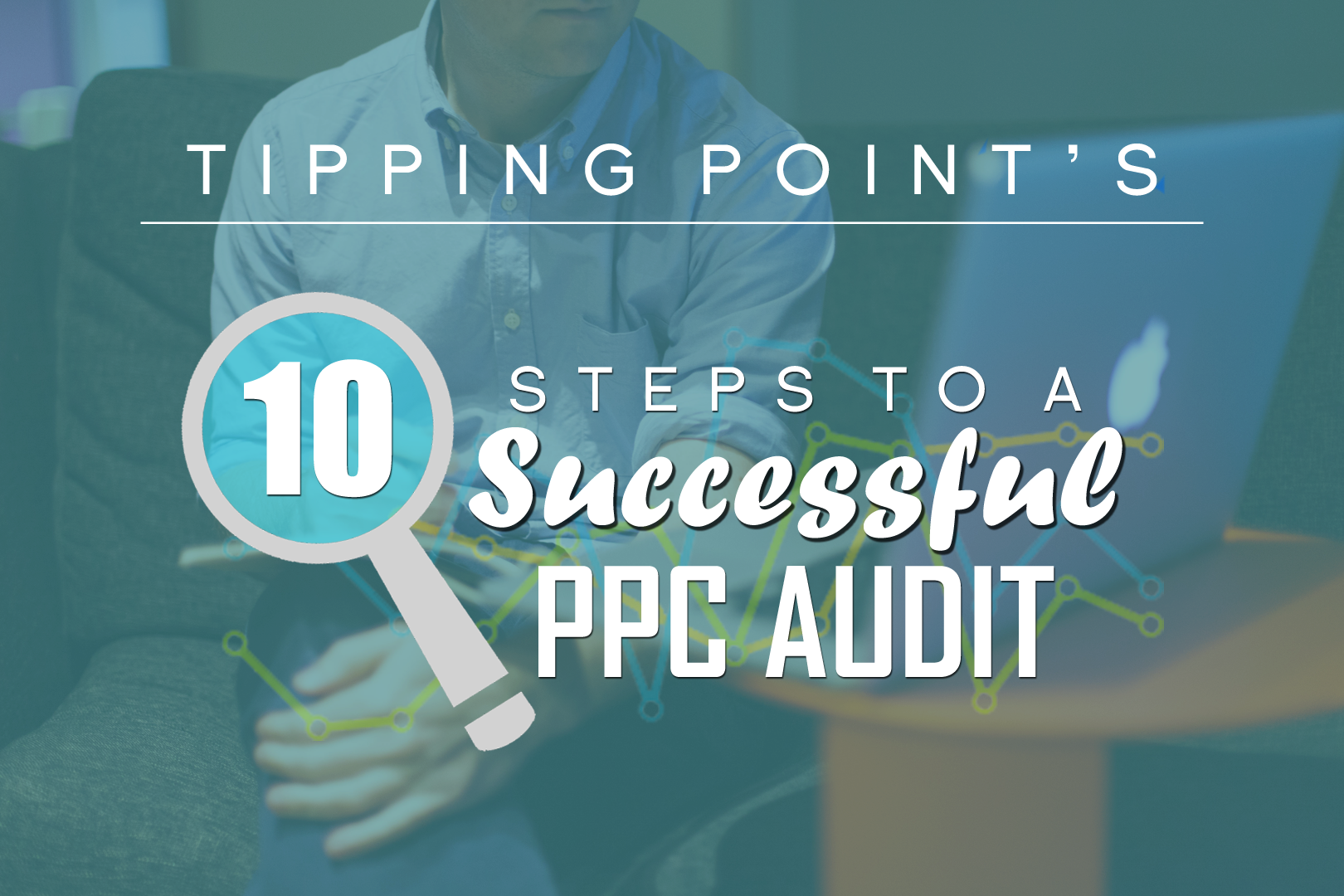Last month we covered the basics of pay-per-click advertising with our beginner guide to PPC. We talked briefly about conducting a PPC audit to optimize your paid ad performance. Just as promised, this week we’re delving a little deeper into how to conduct a PPC audit. In fact, we’ve created a 10 step structure to follow when conducting your audits. In case you’re not familiar with account auditing at all, we’ll start with the basics.
What is a PPC audit?
Simply put, a PPC account audit is the review of an account to identify areas that need further work or attention. Audits are conducted in order to improve the performance of ads. Our 10 step process to doing so will follow shortly.
Why and When Should you audit?
Audits will reveal areas where the budget is not in alignment with overall campaign goals. This is especially useful when heading into peak seasons where it’s important to ensure that budgets are not constraining sales. Generally speaking, you can conduct an audit at any time, because there will more than likely always be something that needs improvement. However, you don’t want to perform an audit after a recent account or strategy change. The reason being that you will not be able to accurately measure the results of your new changes if they aren’t given some time to play out. If you are running PPC accounts in-house, then it’s a good idea to conduct quarterly and year-end audits. Quarterly analysis of your accounts help you plan out your activities for next quarter so you’re not just maintaining your accounts, but growing them as well. If you belong to an agency, then it’s good habit to always perform an audit when first taking on a client’s account. Conducting an audit for a client will help you identify how the account functions and produce a better engagement strategy. Even though it’s an agency’s job to be on top of account activity in the first place, conducting a quarterly audit still holds use. Quarterly audits followed by deep planning sessions with the client can help strengthen account relationships. At the very least, audits should be conducted at the end of each year.
Who should perform the audit?
This is a tricky question, because it depends on the situation. If you’re auditing an account to address a particular issue, then it’s best to have the person in charge of the account conduct the audit. That person knows the account the best and will be able to dig directly into it to quickly find the areas that could be contributing to the problem. However, if you’re looking to conduct a more comprehensive check then the person who does the day-to-day management of the account should never do the audit! The reason being perspective and bias. A day-to-day PPC manager knows how the account is supposed to function and why decisions were made. However, an audit should look at the bigger picture and trends. An audit should examine both data and best practices, as well as, challenge why decisions were made.
When performing an audit, these are the 10 steps that can be applied to any account:
1) Select A Relevant Date Range
Before analyzing any data, you should first select the right time range to view your data across. It doesn’t do much good to look at a months worth of data, because odds are that that data isn’t statistically relevant enough. At the very least you should set your range to be 3 months in order to diagnose a specific issue and a year when performing a general audit.
2) Manage The Account Settings

This is one of the best areas to audit because specific settings tend to be set up when a campaign is started and then rarely revisited thereafter. One of the biggest mistakes we often see are campaigns that are set to target both search and display traffic. This is the set option by default in AdWords which is okay, because it’s set up that way to bring in more traffic. However, that traffic isn’t necessarily high quality. You should instead create separate campaigns for display and search. Keywords between the two networks behave differently, so the ad groups need to be structured differently. Also, keep in mind that your audience will differ between each network.

You may want to consider setting up location targeting. If your clicks are coming from locations you don’t want to target you can remedy this in the settings by selecting the “people in my targeted location” under the target settings. Aside from targeting and ad network options, you can also play around with device targeting, ad delivery method, and ad rotation.
3)Analyze The Campaign Structure
When diving into the actual account, the first thing you’ll want to look at is the campaigns. You’ll want to start with the campaign naming structure. What you don’t want to see are campaigns that are just numbered 1-20. Instead, what you’ll want are campaigns that have been given unique names that hint to what kind of ad groups you’ll find under each campaign. As we just previously talked about, you’ll want to make sure that your campaigns are separated into search and display networks and aren’t targeting both at the same time. Interest category and topic campaigns should also be separated rather than folded into one general display campaign. Checking out the campaign structure is the best place to start to determine whether the rest of the account will be logically organized, or if the the remainder of the audit will require some extra decoding work.
4)Analyze The Ad Groups
Assuming the campaign structure is laid out in a reasonable way, you can then move on to analyze the ad groups. If you have general product categories as your campaigns then your ad groups should be subcategories for those products. Each ad group should have a maximum of 20 keywords in it. It’s important to make sure your ads aren’t too wide reaching as this will make copy writing to match the terms very difficult.
5) Run A Search Term Report
It’s incredibly important to make sure that your keywords are matching with relevant searches. Too often we find that advertisers are investing money on terms that just aren’t good enough or aren’t 100% relevant. Spotting and eliminating these terms can cut down on a lot of wasted spending. You can look at your search query report in AdWords by clicking on the details button under the keywords tab. Once in the details drop down, you’ll then want to select “all” under the “search terms” heading.
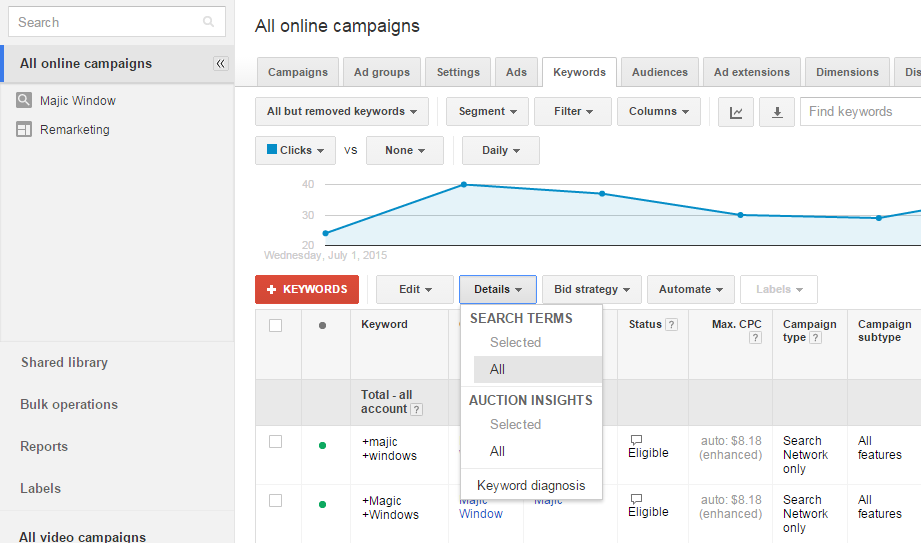
When auditing keywords you’ll want to take note of how many broad, exact, and phrase match terms are being utilized. If a majority of your terms are broad match, then an easy modification to increase ROI would be to add more phrase and exact match terms. You’ll also want to have a logical negative keyword strategy in place to weed out irrelevant traffic. Negative keywords are words that match and trigger an ad, but aren’t necessarily relevant to the ad itself. For instance, if you sell sunglasses there’s a chance that the search term “wine glasses” could trigger your ad, but a search for wine glasses won’t be relevant for your sunglass business. Therefore, you’ll want to add wine glasses as a negative keyword so that your ad no longer shows for that search term. Additionally, it’s a good idea to implement modified broad match keywords. You’ll want to assess whether bids for keywords have been set too high or too low to produce results or maintain goals. You’ll also want to analyze the search term report to make sure you aren’t missing any high traffic or high converting keywords that should be added to the account structure for increased profitable reach. Last but not least, you’ll want to make sure your keywords are grouped into the right adgroups. As you probably already know, having a high quality score can save you a tremendous amount of money on your advertising. Therefore, you’ll want to maximize your chances of getting as close to 10/10 as possible. Also, grouping keywords into tight groups helps to improve click-through rates assuming the ads are already well written. Increasing your CTR will have a huge impact on your quality score and reduce your adcosts that much more.
6)Manage Your Ads
When looking at ads in any given account, make sure to keep the basics in mind. You’ll want to check for basic spelling and grammar errors and ensure that there are no expired offers or deals being advertised. Additionally, you’ll want to perform an ad test. Cardinal Path offers a nice and easy free ad testing tool. No ad copy is perfect and so it should always be tested to further enhance performance. It’s important to not only come up with incredible copy, but to also test how that copy ends up displaying. Having a period at the end of the first line of an advertising message will lead to a larger headline when displayed in the first three positions on Google. This technique catches users’ eyes and allows extensions to stand out more. It’s good practice to include product features or the benefits in the first line of an ad in order to better attract the eyes of a potential customer.
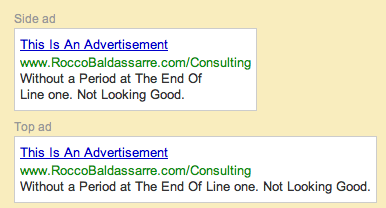
Above you can see an ad without a period in the first line vs. an ad with a period in the first line below. Can you see the difference it makes?
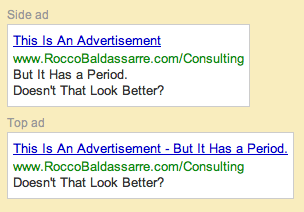
Ad extensions are also quickly becoming a crucial component to campaign success. In fact, extension use is now an important element in the quality score formula. There are a lot of different extensions your ads could utilize, but you’ll want to make sure you’re at least using all of the following extensions:
- Site Links
- Call Extension
- Location Extension
- Social Extension
- Review Extension
Advertising extensions can be found in Google AdWords under the extension tab on the adgroup or campaign levels.
7)Optimize Your Quality Score
What you end up uncovering within your quality score could take some time to correct. We already talked about one way to increase your quality score by grouping your keywords into the right adgroups. The most important part of this portion of the audit is to pull a few key reports and analyze them. In analyzing your account’s performance you can get a feel for where you need improvement and take action to make corrections. Optimizing quality score is an entire blog’s post worth of content on its own. PPC Hero has an excellent post on how to increase your AdWords quality score.
8) Manage Your Network Settings

After spending time working with your AdWords settings, your campaigns should now be divided into search and display networks. You’ll want to focus on the display networks. You’ll want to click on the “placements” button in the navbar under the “display network” tab. It’s good to have a mix of display ads that are running automatically and those that are running as managed placements. For the auto placed ads you’ll want to see if any of the ads should be moved or managed. For managed placement ads you’ll want to make sure the ads are hitting target goals. It’s also good practice to create ads of varied image sizes to fit many different placement types, as well as, varying styles with a mix of images and text.
9) Optimize Your Remarketing
If you don’t already have remarketing implemented into your PPC strategy, you may want to seriously consider adding it. Remarketing is a great tool to capture past web visitors and app users who didn’t convert. If remarketing campaigns are being utilized you’ll want to go to the shared library section of the account and take a look at the audiences that are set up for remarketing.

You’ll want to make sure all of the audiences are collecting members. You’ll also want to make sure you’ve set up an audience for each abandonment level within your conversion funnel. Additionally, you should look to make sure that the cookies have been set up with lengths that make sense.
10) Link AdWords With Analytics
If it isn’t already, you’ll definitely want to link your AdWords account with Google Analytics, because this can save you a lot of time and money. You can link Google Adwords with Google Analytics by clicking on “my account” and then 0n “account access”. From there you can then click on “linked accounts” and move forward with Google Analytics linking.
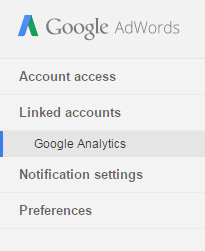
There are two features with Google Analytics that we strongly recommend using within the AdWords interface.
- Evaluate the average time on site of keywords and find out if your landing page is performing poorly, or if you need to pause many of your keywords.
- Evaluate the bounce rate by advertising messages to find out what kind of messages produce the best results.
After The Audit
After finishing up your audit you’ll probably have compiled a decent sized list of things within your account that need your attention. You’ll want to take some time to prioritize your list. If you conducted an audit to address a specific issue then you’ll want to make correcting that issue your highest priority before moving on to address anything else you uncovered along the way. If you conducted a general audit then you’ll probably want to prioritize your work by assigning the highest priorities to the changes that will have the biggest impact to the bottom line, or according to the amount of time it will take to complete each task.
In Conclusion
Conducting a PPC audit will ensure that your campaigns are giving you the most bang for your buck. There is no cookie cutter audit. However, you can apply these 10 steps as a basis for auditing any PPC account. If you do, your accounts will end up in great shape. If you’re strapped for time, we could certainly come in and audit your accounts for you. PPC happens to be one of our specialties. Feel free to peruse our prior work history and don’t hesitate to contact us! Additionally, WordStream has a free quick and easy PPC Audit tool you can use to get your account in shape in a snap. It’s certainly worth taking a look at.
